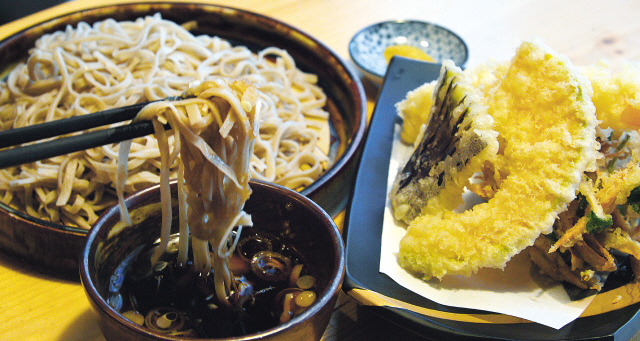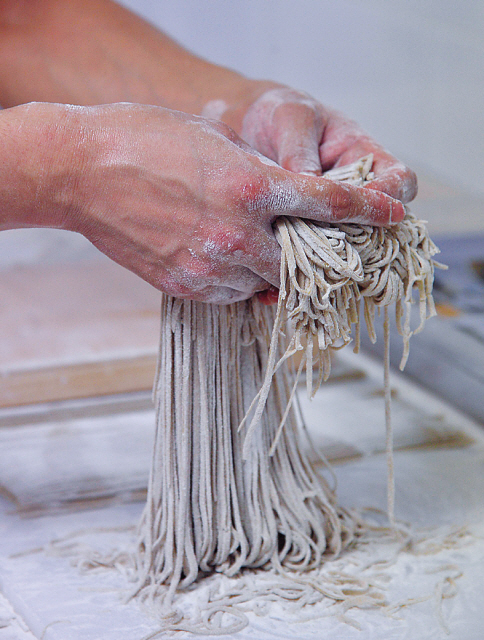 |
Miuya’s tenmori soba pairs cool and refreshing buckwheat noodles with crisy, piping hot tempura (Lee Sang-sub/The Korea Herald) |
Handmade soba perfect antidote to hot summer days
The craft of soba-making is in the dough, says Miuya chef Nam Chang-su, who went on to explain why the restaurant, which opened near Yangjae Stream this March, specializes in handmade soba noodles.
“With handmade soba one can enjoy those aromas and flavors characteristic of this kind of buckwheat noodle,” the 32-year-old chef said.
Soba noodles, once a quick and therefore oft-consumed dish among Japanese laborers in Edo in the 1600s, is now an internationally popular dish, often enjoyed cold, with a dipping sauce.
The buckwheat noodles can be found in its dried, packaged form in supermarkets, along with the dipping sauce, ready-made and bottled for use, so that the meal can be enjoyed at home.
Nam believes, however, that handcrafted soba has its own merits, merits that make it worth the trip out of the house and into the sweltering weather for a heap of Miuya’s cool buckwheat noodles.
We will leave the debate over handcrafted and commercial soba to the experts, but it is the belief in the tastiness of artisanal soba that is the driving force behind Miuya, where fresh dough is made from four parts domestic buckwheat, one part flour and then crafted into noodles, every day.
To make soba noodles, Nam rolls the dough out carefully, using two incredibly long rolling pins. As the dough grows and stretches, Nam wraps wide swathes of it around one of the pins, so he can anchor the dough to the board while he continues to toss flour over it and roll it out with the other pin.
When he is done, he folds the dough carefully, then places a wooden guide over it and starts to cut the noodles with a soba knife, creating a rhythmic percussion of knife-meeting-dough-meeting-board.
After he lightly shakes the noodles free of flour and carefully arranges them in neat bundles in a tray, he will cook them to order, adjusting the time to suit the heft of the noodles, but, nevertheless keeping it short and brief, so that the noodles are never in danger of becoming mushy.
The entire process looks arduous. Yet, according to Nam, the real deal breaker is the dough, and if the resulting noodles served at Miuya are an indication of the quality of the establishment’s dough, then the dough is good.
Thin-cut and delicate, the noodles are glossy, smooth and slightly chewy, redolent of that telltale nutty aroma one finds in buckwheat.
When ordered cold as zaru soba, Miuya’s buckwheat noodles are the perfect antidote to the tropic humidity and heat plaguing the city this summer.
A tangle of speckled noodles is served, with a dipping sauce and the requisite mounds of wasabi, curlicues of green onion and grated daikon radish.
All one must do is tip the wasabi, green onion and radish into the sauce and stir. The next part is a little trickier.
The dipping sauce is relatively salty and strong, requiring one to quickly douse the tips of the noodles, one small bunch at a time, to prevent sauce overload.
No, this is not a seasoning fluke. According to Nam, the spotlight is on the noodles themselves, meaning one is not meant to soak the noodles in the sauce, but to just dip them, so that one can enjoy the flavor of the soba.
Dip lightly, because the noodles are good, even without the sauce, which might be why one can upgrade the standard 150 gram serving of cold soba noodles to a 250 gram super-size serving.
In addition to the standard zaru soba (a.k.a mori soba) Miuya serves eight other cold variations of soba and six variations of warm soba.
“We wanted to let people know about soba,” said Nam.
 |
Soba noodles are made fresh daily at Miuya from four parts domestic buckwheat and one part flour. After rolling out the dough and cutting it, the noodles are shaken free of excess flour. (Lee Sang-sub/The Korea Herald) |
Miuya1F Kijung Building, 116-5 Yangjae-1-dong, Seocho-gu, Seoul; open 11:30 a.m. to 2:30 p.m., 4:30 p.m. to 8:30 p.m. daily, closed Sundays and every second Monday of the month; soba costs 8,000 won to 15,000 won; (02) 577-6348
By Jean Oh (
oh_jean@heraldcorp.com)









